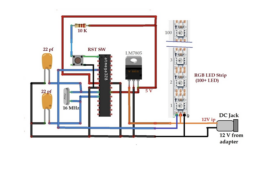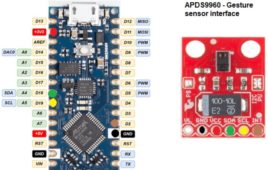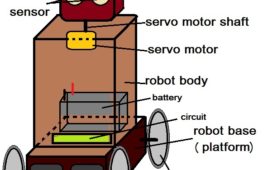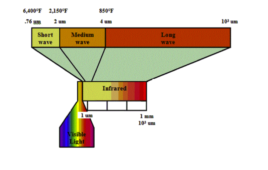In this project, we’ll demonstrate how to make a colorful, king-sized coconut tree (5 feet) decorative showpiece using a digital RGB LED strip. The RGB LED strip is cut and arranged to form the shape of a coconut tree. The ATMega328 microcontroller is used to control the LED strip, generating several flashing, fading, and blinking…
RPi Python Programming 24: I2C explained
In the previous tutorial, we covered how to interface a NEO-6M GPS module with Raspberry Pi (RPi). The module communicates with RPi over the universal asynchronous receiver/transmitter or UART protocol. The UART is the most common point-to-point data communication protocol. But, it’s not the only serial communication protocol. In embedded electronics, I2C and SPI protocols are…
Measuring spikes in stress levels using a galvanic skin-response sensor and Arduino
A galvanic skin-response (GSR) sensor is used to measure the stress levels or emotional spikes in people it’s reading by using two special electrodes. When in a reactive or stressed state, the human body’s sweat glands are activated. This sudden elevation in sweat can be picked up and recorded by the electrodes of a GSR…
How to measure distance and gesture using the SparkFun ZX with Arduino
In this tutorial, we’ll learn how to measure distance and gesture by using the SparkFun ZX sensor and Arduino. Movement can be difficult to predict. However, advanced computer technology and artificial intelligence (AI) can detect gestures with ease. One of the least costly ways, however, is via an infrared (IR) sensor. The IR receiver on…
Smartphone-operated RGB LED Strip
In the previous article of this series, we learned how to change colors in RGB LED strip using any IR remote means generating different colors in RGB LED strip with your fingertips from a remote place using any IR remote. So indeed, it was a very nice application. This time again, we are moving one…
How to measure the turbidity in water using Arduino
In this tutorial, we’ll learn how to measure the turbidity in water by using a sensor with Arduino. Turbidity refers to the relative clarity of a liquid. It’s a measure of the suspension of heavy particles, dust, and other matters (liquid/solid) that may leave water cloudy, unclear, or dense. For example, a heavy concentration of…
How to monitor pH levels in an aquarium using Arduino
One of the most important elements of any aquarium is oxygen. Even though water is part oxygen, it’s bonded with hydrogen, which is tough to separate and breathe in — even for fish. In open streams and oceans, oxygen is dissolved in the water through the open air, rainfall, and the flow of the tide.…
TV remote hack using Arduino and IR sensor
In this tutorial, we will learn how to hack a TV (television) remote using Arduino. TV remote communicates with TV using infrared rays. Encoded commands and transmitted by remote, TV internal circuitry decodes them and performs an action on received commands. On the front of the remote, we have an IR led which emits IR…
Gesture sensor using Arduino
Gesture recognition is a heavily studied and experimented topic around the globe. Tech companies are aggressively spending resources to get a breakthrough. Pushbutton and touch technology is in use for quite a long time. New and better technology is key to capture the market. This made the entire tech industry focus on new technologies. Among…
How to build a metal detector using an inductive proximity sensor with Arduino
In this tutorial, you’ll learn how to build a do-it-yourself (DIY) metal detector using a proximity sensor with Arduino. Many similar projects use a coil and transistor, but it’s possible to use a proximity sensor instead of a coil. You’ll simply notice a difference in the range and power consumption. The range of proximity sensor…
Object follower robot using Arduino
This is a very nice and interesting robotic project. As the name suggests, “object follower robot” – the robot is meant for following an object. You might have heard of… A smart luggage trolley at railway station/bus station/Airport that automatically moves on battery and motor and it follows the owner A smart cart at any…
Sending a text message using SIM900 GSM with an STM32 microcontroller
In this tutorial, we’ll learn how to send a text message using an STM32 microcontroller and SIM900 GSM module. The SIM900 can communicate with an external controller by using the universal asynchronous receiver-transmitter (UART) interface. This means that any controller with a UART module can “talk” with the module. Fortunately, most STM32 microcontrollers have one…
How to use an STM32 microcontroller to measure external signal frequencies
In this tutorial, we’ll learn how to measure frequency by using microcontrollers. Unfortunately, microcontrollers are not equipped with frequency-measurement functions. So, for this project to be a success, we’ll need to interface multiple microcontroller peripherals before we can sufficiently measure the frequency of an external signal. Two of the most common methods for measuring the…
Non-invasive current sensor with Arduino
The idea of noninvasive current measurement is not new. Commercial devices are available which can measure current without any physical contact. However, the topic was not popular among the DIY community because of the complexity and nonexistence of the compact non-invasive sensors, which could be studied at low power. Luckily, we have small and reliable…
Interfacing Nextion HMI with MCU
In the previous tutorial, we learned how to use the Nextion HMI editor. In this tutorial, we will is studying the advanced features of the HMI and learn how to interface an external microcontroller with nextion HMI. Our focus will be on communication protocol, command set, and data synchronization. Nextion HMI talks with external modules…
How to use a LiDAR sensor with Arduino
LiDAR, or “light detection and ranging,” is a remote-sensing method that uses light in laser form to measure distances or ranges. LiDAR has been used for decades although there are more recent advancements in the technology. These include laser scanning and processing speeds that make 3D mapping possible and accessible. This technique uses light (precise…
Arduino-based token display board controller
You must have noticed token display boards at many places like food stores, hospitals, banks, various takeaways, etc. Token display systems are used to display token numbers. As these display boards show numeric information, these are easily designed using 7-segment LEDs. The commercial models use large 7-segment LEDs to display token numbers. It is even…
Arduino audio player
This tutorial is about building a DIY audio player using Arduino. Today audio players can commonly be found across many electronic products. Almost every mobile has an audio player. Audio technology gets a drastic improvement with rapid development in silicon technology. Previously audio data was stored on tape devices and CDs. But now, Flash memories…
Using a flame detector with Arduino
In this tutorial, we’ll learn how to detect fire or a flame using Arduino. Since fire generates heat, it’s possible to measure it via a sensor that tracks the temperature of the environment and converts it into data that can be monitored. However, a temperature sensor is not always a reliable solution for distinguishing fire…
How to use a thermal camera with Arduino
In this tutorial, we’ll learn the basics of “heat vision” and how to interface a thermal-imaging camera with Arduino. Of course, humans cannot see heat directly, but objects do give off infrared radiation at a certain temperature. Although infrared light is invisible to the naked eye, a thermal camera can detect it. A thermal camera…




















